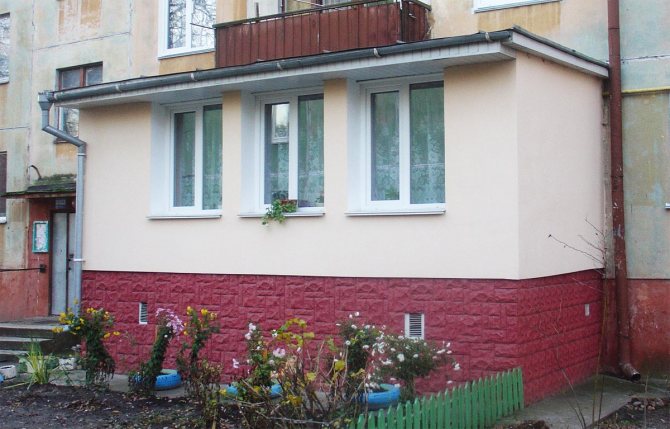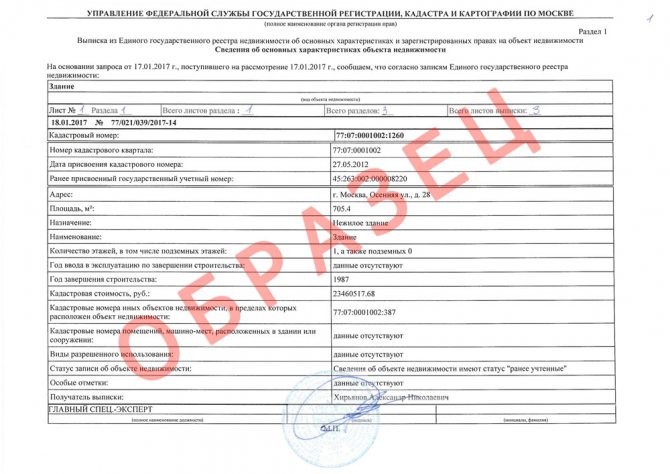What is an extension to a building and what work does it fall under?
Each object cap. construction has individual parameters, including dimensions (length, height, width), area, volume. These parameters are initially described in construction projects, and after completion of the work they are confirmed in technical passports and plans, information from the Unified State Register of Real Estate and BTI inventory files. During the existence of a building or private house, its initial parameters can be changed. To do this, a superstructure or extension can be carried out, or individual parts of the object can be dismantled.
As follows from the definition, an extension to a residential building or non-residential building entails an increase in area and volume, and therefore a change in the initial parameters. Such construction work falls under reconstruction, which requires mandatory approval. Based on the results of the work, the volume of the added part will be united by common boundaries (external walls) with the original structure. For this purpose, common internal spaces, passages, utility networks and communications are made. It is also possible to equip a separate exit from the attached part to the area under the building.
Expert commentary. A new independent facility can be built in close proximity to the building. In some cases, if construction, sanitary and fire safety standards allow it, it can be closely adjacent to the original structure. In such a situation, we are not talking about an extension, but about the construction of a new building that will have individual characteristics. These works need to be approved not as reconstruction, but as the construction of a new facility.
The extension provides for an increase in the volume and area of the original building. Therefore, it needs to be agreed upon in the form of reconstruction.
Regulatory acts
To carry out any construction work that entails a change in the characteristics of the object, it is necessary to approve the project. The approval mechanism and design rules for the extension must comply with the following guidelines:
- Town Planning Code of the Russian Federation () - describes approval options, general requirements for documents and work safety;
- Law No. 384-FZ () - defines safety standards for buildings and structures that must be observed during construction and reconstruction;
- Law No. 123-FZ () - contains fire safety standards that must be observed during construction work in relation to structures and materials of buildings;
- Resolution No. 87 () - describes the content of the sections of the project that must be ordered for the extension.
These are general regulations that apply to all construction and renovation options. If there are special rules that apply to certain types of buildings. For example, if legalization of an extension to an apartment building is required, the project and other documents must comply with SP 54.13330.2016. The same building rules, standards and regulations must be chosen for other types of objects.
A permit for an extension to a private house is issued if, as a result of the work, the total area and volume of the original structure increases. Coordination takes place by submitting notifications to the local government authority. These notifications are used to check whether the extension complies with safety standards.
Calculator of the cost and timing of our services - here
How to design an extension to an apartment building
Most of the urban population of our country lives in apartments in multi-storey buildings. Owners of apartments located on the first floors of such houses expand their living space by adding a veranda or an additional balcony to the external main walls of the building. Therefore, at the end of the article, it would be useful to tell you how to obtain permission and apply for it in this case.
The process of obtaining a building permit and further registration of an extension to an apartment building is not much different from similar registration in the private sector. However, in this case, you will have to coordinate the construction with all residents of the house and obtain permission from the owner of the house.

Extension to a high-rise building
The necessary documents are submitted to the architectural department of the municipality, where the application is considered and a decision is made. The reason for refusing permission to build an extension may be the fact that the apartment building is an architectural monument. To make a positive verdict, it is better for the apartment owner to privatize the plot of land on which the construction of the extension is planned.
Types and extension options
The design of the extension is carried out in different versions. Here are the types of construction work that the owner of the building and site can carry out:
- expand the dimensions, increase the area and volume, i.e. as a result of the work, the attached part will be combined and limited by common external walls with the main building;
- you can attach a new independent object with its own external walls, separate exits, and engineering systems in close proximity to the building;
- an extension can be a temporary or non-permanent structure that does not fall under the characteristics of a real estate property (for example, it could be a pavilion, a cafe or restaurant terrace for the summer).
There are specific features for coordinating and constructing the listed types of extensions. For example, if a new facility is being built, fire safety standards (including the distance of fire breaks), natural light for the main building and nearby buildings, and other standards must be observed. Compliance with mandatory standards will be indicated in the project, and they will be checked during the examination when issuing a permit for reconstruction.
Expert commentary. There is another type of objects - built-in and attached premises. They may have different purposes with the main structure. For example, in an apartment building, built-in and attached premises can be used for retail and office purposes. In some cases, the specified object can be placed on independent cadastral registration. You can learn more about these nuances from the specialists of our company.
| No. | View of the reconstructed object | Where does the approval take place? |
| 1 | Reconstruction of an apartment building or non-residential building | Permits for construction and commissioning are issued by Gosstroynadzor. After completing the work, you need to contact Rosreestr and make changes to the Unified State Register. |
| 2 | Reconstruction of facades | The project needs to be approved by Moskomarkhitektura. If the characteristics of a building change, permission for construction and commissioning is issued by Gosstroynadzor. After completing the work, you need to contact Rosreestr and make changes to the Unified State Register. |
| 3 | Reconstruction of individual houses | Before the start of work and after its completion, notifications are submitted to the local administration. Changes to individual housing construction must be made to the Unified State Register through Rosreestr. |
| 4 | Reconstruction of hazardous industrial facilities | Permits for construction and commissioning are issued by Gosstroynadzor and Rostekhnadzor. After completing the work, you need to contact Rosreestr and make changes to the Unified State Register. |
| 5 | Reconstruction of linear objects | Permits for construction and commissioning are issued by Gosstroynadzor and Rostekhnadzor. After completing the work, you need to contact Rosreestr and make changes to the Unified State Register. |
Types of extensions to a private residential building
The specific steps for designing an extension are determined by the type of building.
Based on their purpose, buildings for commercial and residential purposes can be distinguished. Depending on compliance with the requirements of building legislation, extensions can be:
- Legal, that is, built on the basis of the necessary permits and in compliance with regulations and standards.
- Unauthorized. The Civil Code names 3 signs of unauthorized buildings. In the case of extensions, most often we are talking about recognizing them as unauthorized due to failure to obtain special permits.
The most important classification criterion from the point of view of legalizing an extension is the level of complexity of the structure being built. According to this criterion, buildings are divided into:
- capital;
- non-capital.
What is needed to approve an extension to an existing building
Legalization of an extension is possible if a project has been drawn up for the work and has received a positive expert opinion. The reconstruction project contains architectural, structural, engineering and other solutions that ensure an increase in the total area and volume of the building, combining the main and attached parts into a single whole.
An extension to a private house is also subject to reconstruction, but has a different approval procedure. The notice, which the owner submits to the local government, describes the types of work and future characteristics of the individual housing construction house. It is permissible to submit a notice of the start and completion of work without a project. In practice, even for work in a private house, a project is needed to ensure safety and compliance with building and fire regulations.
Permission for an extension is not the only legal requirement. Since an increase in the area and volume of a building entails a change in its basic parameters, the owner needs:
- order a technical plan from a cadastral engineer after completion of the work (this document will describe the new parameters of the structure, taking into account the attached part);
- contact the BTI and make changes to the technical plan if the object is registered for technical registration;
- register with Rosreestr to update the USRN information.
The main object will not lose its existence, although it will significantly change its characteristics. Therefore, deregistration in Rosreestr and cancellation of the cadastral number do not occur. An extension to a building will be considered finally legalized if information about it is included in the Unified State Register of Real Estate. For the owner, such confirmation will be an extract from the register.

Permission for reconstruction is issued by Gosstroynadzor on the basis of the project and a positive expert opinion.
How to legalize an unauthorized extension to a house
Often, owners of private houses unauthorizedly build major extensions without the appropriate permission. Households with extensions that are not properly registered cannot be sold, rented out, or inherited on them until they are legalized.
An extension erected in the wrong place cannot be registered, and in accordance with the law it is subject to demolition voluntarily or compulsorily. If during the construction of the extension the requirements of SNiP were not violated, even though it was built without permits, it can be legalized in court.
To legalize it in court, the owner needs to conduct a technical examination and inventory of the structure, which will cost the owner a considerable amount, and also prove that the structure does not infringe on the rights of neighbors and does not violate existing building regulations.
As a rule, with a positive expert assessment, the availability of documents on ownership of the house and land, and the conclusion that the extension does not affect the interests of third parties, the court allows the registration of unauthorized construction. With the court's decision, you need to contact the State Insurance Company with a statement about the need to make changes to the Unified State Register of Real Estate (USRN).
How to obtain permission for an extension
A permit for an extension to an apartment building, individual housing construction or non-residential building is issued in accordance with the Civil Code of the Russian Federation. Each type of object has its own nuances that the design organization must take into account. From our company you can order design and technical documentation for any type of construction work, support for approvals of extensions to a residential building or non-residential building. Read below for the most important points about obtaining permits.
Extension to a non-residential building
It is possible to attach a new part to a non-residential building on the basis of permission from the State Construction Supervision Authority. To obtain this document, you must:
Calculator of the cost and timing of our services - here
- obtain the consent of all property rights holders for the upcoming work;
- order engineering surveys and pre-design surveys, obtain a technical opinion or report;
- order a reconstruction project from an organization that is part of a specialized SRO;
- submit the project for examination and receive a positive conclusion;
- submit documents to Gosstroynadzor to obtain a permit.
After completing these procedures, you need to submit a notification to begin work. During the reconstruction, ongoing construction supervision will be carried out. When the work is completed, a permit for commissioning is issued. This document is also issued by Gosstroynadzor.

When reconstructing, the extension must be attached to the main building. For this purpose, common walls are erected and passages are made.
How to design an extension to an apartment building
It is much more difficult to legalize an extension to an apartment building, since safety standards for apartment buildings are much stricter. If it is planned to expand the total area and volume of the house, an additional requirement will be to obtain the consent of the owners. This is necessary in any case if work is to be done on common property, which includes MKD structures. The consent of the owners is confirmed by the minutes of the general meeting. It is impossible to oblige the owners of apartments or non-residential premises to give consent, and a negative decision cannot be appealed.
There are also special options for attaching to MKD premises. Here are their features:
- an extension to an apartment in an apartment building is allowed only on the ground floor, and can be expressed in the form of a balcony, terrace, loggia, or a separate entrance;
- when transferring an apartment to non-residential premises, an extension can also be erected in the form of an entrance group (staircase, vestibule, ramps for people with limited mobility).
The listed extension options in Moscow are allowed according to Resolution No. 508-PP. Since these works will be carried out on common property, it is also necessary to obtain the consent of the owners of the apartment buildings. An extension to an apartment building on the ground floor to create new premises is also accompanied by a meeting of copyright holders.
A non-permanent extension to an apartment building is not subject to reconstruction. Therefore, there is no need to order a project, undergo an examination and gosstroynadzor. However, the attached part will be located on a site under an apartment building, so holding a general meeting of owners is mandatory even in this case.

The most difficult thing is to coordinate the reconstruction of an apartment building, since it poses a threat to the safety of people.
How to legalize an extension to a private house
The easiest way is to get permission to add an individual housing construction to your house. To do this, you do not need to contact the housing inspectorate or Gosstroynadzor. The approval algorithm is as follows:
- the owner fills out and submits a notification to the local administration that he will carry out the reconstruction of individual housing construction;
- the notice describes the essence of changes in the characteristics of the house, including the parameters of the attached part and the main object after completion of the work;
- the notification is checked by local authorities according to construction, fire and sanitary-epidemiological safety standards;
- if all indicators are normal, a response notification is sent to the owner.
After completion of the work, you must again send a notice to the extension to the residential building. The document must confirm that the owner has not gone beyond the parameters of the extension specified in the initial notification. If compliance is confirmed, you can order a technical plan, register and register the extension to a private house.
Expert commentary. How to legalize an extension to a house if it was completed without permits or notifications? This is possible if you confirm the safety of the work performed and the absence of violations of the interests of other owners of nearby properties. For legalization, it is necessary to order a technical plan and submit it to the local government authority along with a notification. Our company’s specialists will provide assistance in completing the procedure.
Cadastral registration and registration
In order to finally legalize an extension to a house or non-residential building, it is necessary to register with Rosreestr. This procedure consists of updating the USRN data, where new characteristics of the structure will be indicated. Since the rights to the property do not change during reconstruction, registration is not necessary.
Calculator of the cost and timing of our services - here
Technical plan
A technical plan must be ordered for any extension options. This document is issued after measurements and examinations by a cadastral engineer. The specialist will describe the new parameters of the object, taking into account the attached part, on the graphic and text part of the technical plan. In particular, the new dimensions (contours) of the object, its new area, coordinates, and updated location on the site will be indicated. The technical plan is issued in electronic form (on disk) and submitted to Rosreestr for registration. You can order the document from our company.

After completion of the work, you must obtain permission to put into operation. This document is also issued by Gosstroynadzor.
When and what extensions need to be legalized?
Knowing the type of building will help you decide on further design actions.
If we are talking about a non-permanent construction, the owners just need to declare it after construction and contact the BTI to reflect the relevant changes in the technical documentation for the property. This procedure applies to minor improvements that do not change the general contours of the house and do not affect load-bearing walls. For example, the construction of a porch, a new entrance, or the construction of a canopy may be considered a non-permanent extension.
If an extension is planned that contains signs of major changes, then in order to recognize it as legal it is necessary to go through a number of procedures. From the point of view of construction legislation, the construction of an extension is considered a reconstruction of a house if:
- the parameters of the house change (number of storeys, size);
- load-bearing elements are replaced or restored.
Legalization can be carried out in two ways. The choice of method depends on whether construction is planned or already exists.
If we are talking about legalizing the planned construction, it is necessary to take care of obtaining permitting documentation before the changes begin. Subsequently, the extension erected according to the law is subject to registration.
Registration of an existing unauthorized extension means recognition of its owner as the legal owner. Perhaps this is only in court. However, going to court does not guarantee the applicant the satisfaction of his claim to be recognized as the owner of the building. The consequence of refusal is the demolition of the building or even the entire house if it cannot be returned to its original condition.
What are the dangers of an unauthorized extension?
An unauthorized addition to a private house does not formally fall under the offenses under the Code of Administrative Offenses of the Russian Federation. In Art. 9.5 of the Code provides for liability for reconstruction carried out without a project or permit. An extension to an individual housing construction does not require a design or permission, and the notification does not apply to such documents. However, if construction and fire regulations are violated, it will be impossible to legitimize the work performed. This makes it impossible to register with Rosreestr and dispose of the property. At the request of local authorities or owners of nearby buildings, demolition of an extension to a residential building is possible. To do this, an order is issued, and then a lawsuit is filed in court.
Illegal reconstruction of an apartment building or non-residential building is punishable under Art. 9.5 Code of Administrative Offenses of the Russian Federation. Carrying out work without permission entails a fine of 2500-5000 rubles. (citizens), 20-50 thousand rubles. (IP), 500 thousand rubles. – 1 million rubles. (organizations). In addition to a fine, the court can suspend the activities of an individual entrepreneur or enterprise for 90 days.
List of useful documents
Documents for download:
| No. | Links | Description |
| 1 | Sample technical specifications for reconstruction | |
| 2 | Sample application for a building permit | |
| 3 | Sample technical plan | |
| 4 | Sample application for cadastral registration | |
| 5 |
| Sample USRN extract |
| 6 | Sample application for a commissioning permit | |
| 7 | Sample application for project examination | |
| 8 | Recommendations for preparing design documentation for examination |
Where and how can I apply for a permit?
Permission to carry out an extension in a residential building is regulated by paragraph 4 of Art. 51 of the Town Planning Code and is issued by local authorities.
List of documents required to obtain a permit:
- copies of passport;
- a certificate from the Unified State Register of Real Estate, which confirms the existence of ownership rights to the land plot on which construction will subsequently take place;
- construction design diagram;
- cadastral passport;
- extract from the urban planning plan.
A certificate from the Unified State Register can be ordered at the MFC upon payment of a state fee of 300 rubles. Document processing time is 3 working days. The extension scheme can be developed by builders or drawn up in an architectural bureau.
Urban planning plan of the area in the city archive. Such a document is not needed if a private house is located in dacha garden communities or outside the city.
Procedure for document preparation:
- preparation of necessary documents for the land plot;
- contacting an architectural bureau to draw up a design diagram of the building;
- contacting the gasification and water supply department with the provision of a project to obtain an act of consent for construction;
- submitting an application to the local administration with a previously completed application for a permit and other documents;
- waiting for the finished document (within 30 days) and subsequent receipt.
When submitting a project, specialists from gas and water supply services must check the overlap of the building with passing communications and eliminate the possibility of an accident.
Capital buildings must be built at a distance of at least 2.5 m from the main lines.
The Committee on Architectural Buildings issues a permit only after checking the site for the construction of a future structure for damage to any communications.
How much does a permit for an extension cost?
The Gosstroynadzor permit is issued free of charge, since it is a public service. The customer pays for the research and design, examination, and preparation of the technical plan. Registration with Rosreestr also does not require payment of a fee. The notification procedure for an extension to a private house will also cost no fees. The owner of individual housing construction at his own expense orders a project (if necessary) and a technical plan. You can find out about the preliminary prices for the services provided by our company from the table below.

Modern technologies make it possible to visualize a future extension at the design stage.
Content
No one will ever tell you the exact cost of landscaping services for a house on a summer cottage in Moscow and the Moscow region. It depends primarily on what documents you have on hand, and on what still needs to be done so that your set of documents can be submitted for registration itself.
Why is it important to register buildings and not build unauthorized buildings on a summer cottage?
Important! A residential building can only be registered on the lands of individual housing construction or private private plots. Only non-residential properties are registered on agricultural lands. An exception is land whose purpose indicates the possibility of constructing residential buildings.
If you have any difficulties or questions, please seek legal advice. You can get free legal assistance on our website. Describe your situation to an expert and ask a question in a special window.
You may like => Administrative responsibility for construction on an unformed land plot
Alexandra Voskresenskaya, lawyer at Yukov and Partners Yukov and Partners Federal rating Group I Bankruptcy Group II Criminal law and procedure Group III Arbitration proceedings 19th place By revenue per lawyer 25th place By revenue 14-15th place By number of lawyers Company profile × , states that in most cases the courts do not satisfy claims for recognition of ownership of an unauthorized construction if, before the start of construction, the developer did not take measures aimed at legalizing the object. In addition, according to the meaning of the norms of the Town Planning Code, extensions to residential buildings may not be classified as capital construction projects, the expert says. When constructing such extensions (for example, a shed) or a garage, a building permit is not required, Voskresenskaya claims: “After completion of the work, it will only be necessary to make changes to the technical documentation.”
How to legalize an extension to a house through court
Increasing living space by adding additional premises to a private household is not uncommon. But here a legal question arises - how to legalize an extension to a house on your own land? This will be discussed in the article.
The following payments also have to be taken into account: State duty for the court - 200-500 rubles Power of attorney certified by a notary from 2000 rubles Making changes to the real estate cadastre - 20,000 rubles Forensic examination will cost from 15,000 rubles.
How to legalize an extension to a house through court? The court will require a forensic construction examination. It is usually appointed by a judge. However, such a procedure can be carried out independently at the stage of filing an appeal to the court.
Illegal extension to a house - legal advice
The cost of representation in court depends on the number of meetings at which the lawyer will have to attend. Payment for each department meeting or combined payment is possible. The presence of a lawyer costs one-time from 6,000 rubles, comprehensive representation is offered from 30,000 rubles.
- Documents confirming ownership of the land and house (if any) in the area where the extension was built.
- Regulatory documentation issued by the housing and communal services service.
- Certificate from BTI.
- Information on the number of registered persons in a given territory. To obtain this information, an extract from the house register is required.
- Project documentation for house redevelopment.
- Plan for the building.
- If the extension is located close to a neighbor's property , their written consent will be required.
- Documents from utility organizations (water utilities, heating networks, gas and fire inspections).
- Certificate of consent for the building from the sanitary and epidemiological station.
- Photographs of the house and plot.
Terms of approvals
The terms of survey and design for the upcoming extension are determined by agreement. They depend on the terms of the technical specifications, the features of the upcoming work and the characteristics of the original object. Review of documents by Gosstroynadzor takes no more than 7 days. After completion of the work, the technical plan can be obtained from our company within 1-5 days. More information about the timing of procedures and registration of mandatory documents can be found by calling us.
| No. | Service, document | Price |
| 1 | Development of a reconstruction project | from 350 rub./sq.m. (depending on the total area of the building) |
| 2 | Examination of design documentation | Calculated according to Decree No. 415, depends on the type of project, type and area of the building |
| 3 | Support of approval and obtaining permits at Gosstroynadzor | from 30,000 rub. |
| 4 | Support of cadastral registration and registration | from 15,000 rub. |
| 5 | Conducting engineering surveys and site inspections | from 30,000 rub. per hectare of land. |
Required documents
If a structure is planned and has not yet been built, it is necessary to seek legal advice to avoid problems in the future. Next, you need to consult with the design organization about the construction project so that it meets all the necessary requirements and standards.
Procedure for legalizing construction
- During construction, the load-bearing wall is affected; this is strictly prohibited.
- If the building is erected close to communications, the distance between them should not be less than 2.5 meters.
- Low-quality, old materials or outdated technologies were used during construction.
You may like => What is required for 3 children in 2021 in the Krasnodar Territory: Land or Apartment
The listed stages concerned those situations when an extension is just being planned. But what if you have already built it? Such reconstruction is illegal. The local administration has the right to sue you. If the court decides to dismantle it, you will have to demolish the building at your own expense.
conclusions
- Approval of an extension to the building is a mandatory requirement of the Civil Code of the Russian Federation, since this work is a reconstruction.
- An extension to a house without a building permit entails a fine under Art. 9.5 Code of Administrative Offenses of the Russian Federation.
- To legitimize the part of the object being added, you need to order a project. undergo an examination and obtain permission from the State Construction Supervision Authority.
- To add individual housing construction to a private house, notifications are submitted to the local government authority.
Our company’s specialists will help you quickly get all the approvals for the extension. All details can be obtained from our consultants by phone.
Legitimation process
You will first need to register the rights to the land plot in Rosreestr and formalize the project for additional construction. It will contain a list of building materials and technical information.
You may like => How many years must an apartment be owned when selling in order not to pay tax 2021
What do you need to know about adding a house extension?
If a negative decision is made in the case, the owner will have to demolish the extension at his own expense. This decision is made when the rights of others are violated or the design itself does not meet the requirements.
It is important that there are attempts to legalize the extension administratively. The owner prepares evidence of these facts. Correspondence with officials, official refusal, acts of authorized bodies, etc. are suitable.
Legalizing an extension to a house without a reconstruction permit is much more expensive than with a permit (notification). The plaintiff bears the legal costs. He pays the state fee for the claim, the appointed examination, appeals, etc.
The procedure for legalization through court
- The land has been privatized by the owner - in this case, it is enough to submit a notification to the administration and begin construction.
- The adjacent territory does not belong to the owner - in this case the work will have to be coordinated with the residents of the house.
Any of these options is a serious reason to worry about the future ownership and right to dispose of property. The faster the issue of illegal building on a private plot is resolved, the fewer problems await the owner.
Independent construction must be coordinated with many authorities that determine the compliance of future housing with standards. If property owners ignore the provisions of the law, big problems can arise if the construction was carried out with violations or a sale is planned. Legalization of self-construction is a mandatory procedure that will help you draw up documents for the property and have full right to dispose of it at your own discretion.
What is recognized as self-construction
The further course of action depends on the specific circumstances of the development and the type of object. For buildings with non-residential premises erected on the territory of a gardening partnership, the algorithm of actions is as follows:
To solve the problem of illegal construction, the so-called unauthorized construction, the so-called “dacha amnesty” was introduced in 2006. It made it possible to register and legitimize houses built on lands for various purposes, including agricultural ones, using a simplified procedure.












